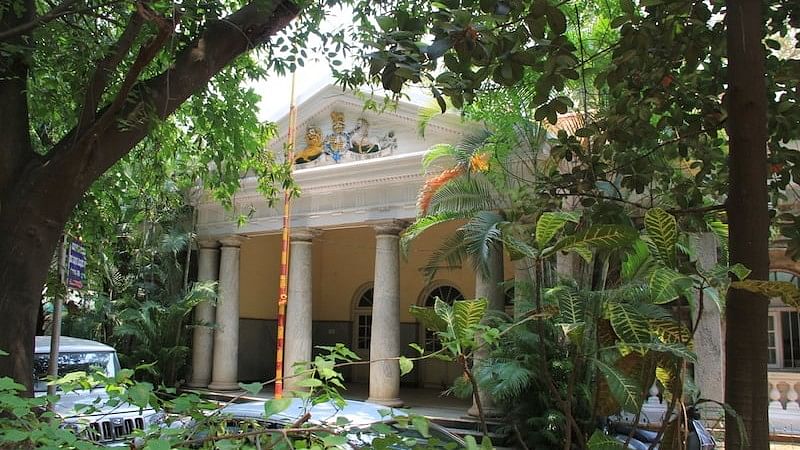
The Doric columns.
Photos by Aravind C
The Office of the Registrar of Cooperative Societies is housed in a building on Ali Asker Road in Bengaluru. All three pediments on its facade are emblazoned with the coat of arms of the king of the United Kingdom. The central shield is divided into four quarters, with three lions in the first and fourth quarters, a rampant lion in the second and a harp in the third. These represent the royal emblems of England, Scotland and Ireland. The shield is held up by a lion and a unicorn. These are usually shown standing on their hind legs, but here in Bengaluru, they are on all fours. Whoever painted the symbol has neglected to paint the horns of the unicorns, so they now look like horses. A wreath around the shield has the French saying — ‘Honi soit qui mal y pense’, meaning ‘Evil to him who thinks evil’. A scroll below has the words, ‘Dieu et mon droit’, meaning ‘God and my right,’ the motto of the king of the UK.
Why is the British monarchy’s coat of arms on a building in Bengaluru, you may wonder. This royal symbol was also used by the British Government of India, and hence by extension, the office of the British Resident in Bengaluru, also known as the Mysore Residency.
The house where the Resident stayed — which was also called the Residency — is today’s Raj Bhavan. In the early 1900s, the Resident had his offices in the building on Infantry Road that now houses the Police Commissioner’s office. The District and Sessions Judge’s courts were also housed here. In the late 1920s, as Bengaluru was growing, everyone needed more room, including the Resident, who needed new offices close to the existing ones.
The plot of land on Ali Asker Road fit the bill exactly. After some correspondence between the Residency here and the government in Delhi for permissions and funds, construction began in 1929 on a new office costing about Rs 77,000. The new building was opened in early October 1930.
Classical features
The structure is a symmetrical stone building, with three wings in a ‘u’ shape around a courtyard, all connected by a colonnaded verandah. Architect Pankaj Modi, technical coordinator at INTACH Bengaluru Chapter, draws our attention to the classical Greek elements on the facade: The plain Doric columns with their defining and typical complement of triglyphs. These sets of three vertical ridges are placed at regular intervals on a frieze above the pillars. Each triglyph has a set of six tiny pegs below it. This frieze runs all around the building.
Triglyphs are probably representations of wooden beams, a throwback to the time when Greeks temples were built of wood.
There are other diverse decorative touches. “The classical Greek facade is combined with arched windows and mouldings, rectangular mouldings above the arches, and finely chiselled stone pilasters, all of which make the structure visually appealing,” says Modi.
Why did the unknown architect of our building on Ali Asker Road choose a facade which draws its inspiration from the Parthenon in Greece?
In European classical architecture, Doric columns, with their simple lines and unadorned appearance, were thought to represent strength and masculinity. Combined with the lion-and-unicorn symbol of the Mysore Residency on the pediments, this building was meant to radiate power and authority.
It is perhaps fitting that this building today houses the Registrar of Cooperative Societies, an office associated with a movement born out of the belief in the power of people working together.
As the architectural historian Edward Hollis said, buildings are ‘capricious, protean and unpredictable.’ Their history can be a tale of constant and curious transformation.
Inside, the building has undergone all the usual modifications one sees in government offices, including granite cladding, false ceilings and so on.
A large, new two-storeyed structure is now under construction, rearing up in the courtyard. The optimist in me is happy that the old building is preserved, as is the lovely tree-filled garden in front of it.
(Meera Iyer is the author of ‘Discovering Bengaluru’ and the Convenor of INTACH Bengaluru Chapter.)